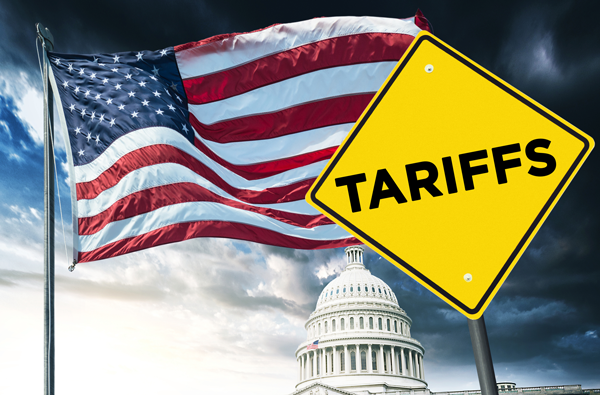

So What Happens to the Grid When Everyone Drives an Electric Vehicle?
Many Californians right now are no doubt feeling the whipsaws of conflicting government policies. Not a month ago, they learned that the state will ban the sale of gas-powered vehicles by 2035, mandating that all new passenger cars and trucks sold in the state must be electric vehicles (EVs).
Then, in a dizzying about-face, residents were asked not to charge their EVs to conserve energy as California’s electrical grid was pushed to the limit due to a punishing heatwave.
A recent Newsweek headline perfectly summarizes the apparent absurdity of it all:

Today, about 1% of our vehicles are electric. What will happen in 2035 when many more EVs need to be charged, potentially during another heatwave? If climate change activists are correct and the temperature continues to tick up, wouldn’t the extra burden of having to charge millions of EVs cripple an already-strained electric system?
Before continuing, I should point out how massive California’s decision is to move to 100% EVs 13 years from now. California is the most populous and wealthiest state in the U.S. If it were its own country, it would be about the size of Poland in terms of population, with an economy the size of Germany’s.
(California also continues to have the nation’s worst air quality, ostensibly a major reason for the aggressive action against emissions. In its 2022 State of the Air report, the American Lung Association (ALA) listed six California counties—San Bernardino, Riverside, Los Angeles, Kern, Tulare and Fresno—as having worse ozone pollution than any other U.S. counties.)
The sheer heft of the Golden State’s auto market means that carmakers will need to ramp up their gas-to-electric transition plans, especially if more states and countries follow California’s lead and implement their own combustion engine bans, which I believe is all but guaranteed.
Crossing the “Chasm” of EV Adoption
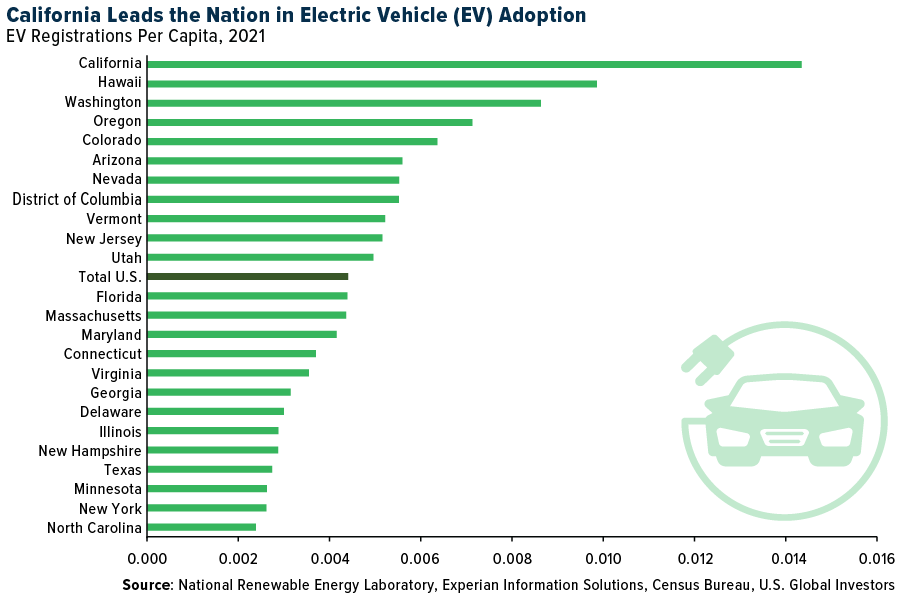
Even before the regulation saw the light of day, California drivers led the nation in embracing EVs on a per-capita basis, as you can see in the chart above. EV sales within the state surpassed 1 million in February, and by the summer, they accounted for more than 16% of all new vehicle sales.
This puts EVs safely within the “early majority” phase of the widely-accepted technology adoption curve, also known as the diffusion of innovation (DOI) theory, developed by sociologist Everett Rogers in 1962.
The early majority phase is past the so-called “chasm,” Rogers’s word for the critical tipping point that separates early adopters and everyone else.
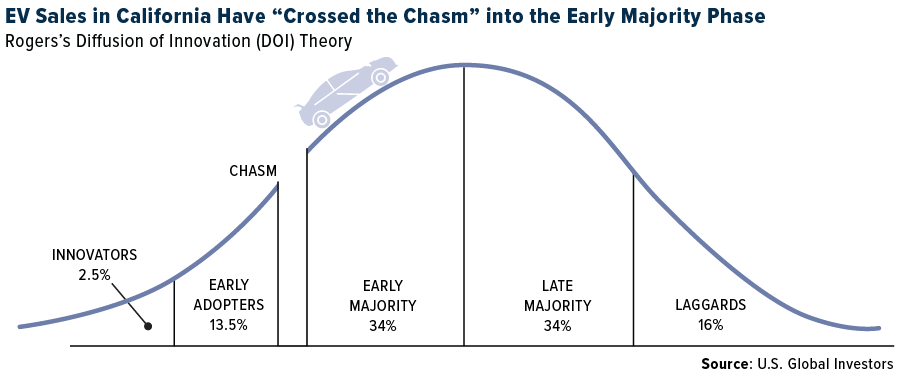
One of the main challenges going forward, as I’ve discussed before, will be to get the state’s charging infrastructure ready to support a fully electric fleet of cars and trucks. California has around 80,000 charging ports, more than any other state, but that obviously won’t cut it in 2035, when millions of EVs are expected to be driving on California roads and highways. At the moment, the state has among the worst EV-to-charger port ratios in the nation, with more than 27 plug-in vehicles per charging port. That’s well above the median U.S. ratio of 14 EVs per port.
I see this as a huge opportunity for electric vehicle charging infrastructure companies. Among the biggest is California-based ChargePoint, with an approximately $6 billion market cap. According to the company’s June presentation, 52% of Fortune 500 companies use ChargePoint solutions, including its hardware, subscription software and other services.
Is Bidirectional Charging the Answer?
That brings me back to the state’s (and country’s) energy grid. Will it be able to support millions more electric vehicles? Will drivers be told not to charge their cars on days of extreme temperatures? By one estimate, California would need to be generating 50% more electricity than it is today if all cars were plug-ins.
One solution is to make sure that new EVs are equipped with bidirectional chargers. Vehicle-to-grid (V2G) technology allows for energy to be sent from the vehicle back into the grid or building as needed.
Not only does this technology provide power to the grid during more expensive high-demand periods, but it could also help reduce the cost of ownership of the EV.
What’s more, owners are able to schedule when they need their car to be fully charged. Even if it’s plugged in all day, smart charging technology will find the optimal time to charge and, if necessary, deploy energy back into the grid.
Right now, the only vehicle available with bidirectional charging is the Nissan LEAF. This week, Fermata Energy announced that Nissan approved its bidirectional charger for use in its newest LEAF model, which will not impact the battery’s warranty. Fermata Energy says that its proprietary V2G system can “turn EVs into mobile energy storage assets, making it possible for owners to combat climate change, increase energy resilience and reduce energy costs.”
With this technology, the hope is that grids will not only be able to support millions more EVs but will actually be strengthened by them.
Solar Deployment to Increase 40% over Next Five Years: Report
But then, aren’t we just transferring emissions from vehicles to coal- and gas-burning power plants?
Today, the answer to that is mostly yes. By 2035, perhaps less so, due to the growth in renewable energy sources such as wind and solar.
As it does with EVs, California currently leads the U.S. in cumulative solar capacity, with as much as 37,086 megawatts (MW) installed, according to the Solar Energy Industries Association (SEIA). The state’s next big solar project, named Project Nexus, will see miles of solar panel “canopies” covering sections of the Turlock Irrigation District’s irrigation canals. The project, which will break ground early next year and be completed in 2024, is expected to generate an incredible 13 gigawatts (GW) of power, which is equal to one sixth of the state’s current electricity capacity.
But what about the rest of the U.S.? The so-called Inflation Reduction Act (IRA), signed into law last month, is expected to be a “massive growth catalyst for the solar industry,” according to a new report by the SEIA and Wood Mackenzie. The groups project nationwide solar deployment to increase by as much as 40% over the next five years (2023 – 2027), even as the industry will remain supply-constrained through the end of 2023.
In the chart below, the green line indicates the SEIA and Wood Mackenzie’s solar capacity installation forecast prior to the passage of the IRA, while the bars represent current forecasts.
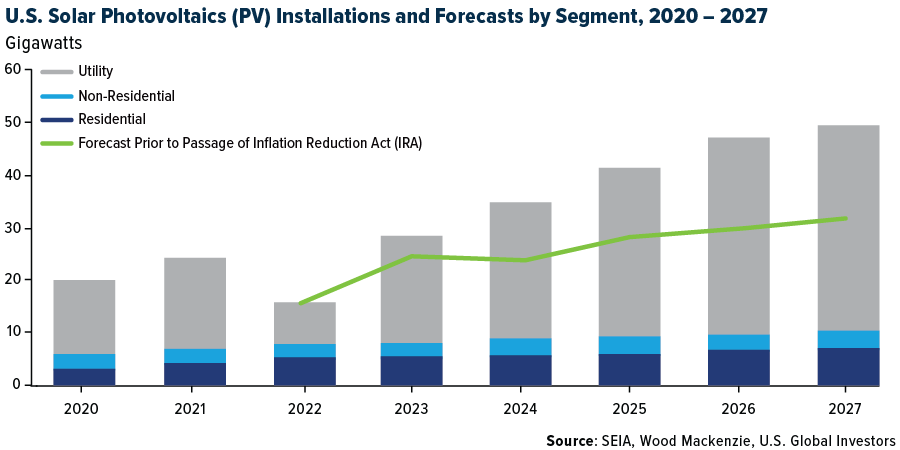
This buildout should benefit not only solar panel manufacturers but also the companies that supply the metals and other materials—silver and copper in particular. Following the passage of the IRA, Arizona-based First Solar announced it would invest up to $1.2 billion to build a new manufacturing facility in the Southwest and to upgrade and expand its Northwest Ohio complex. Shares of First Solar are up more than 55% year-to-date, and up 25% over the past 30 days alone.
Be sure to subscribe to our YouTube channel by clicking here!

Index Summary
- The major market indices finished up this week. The Dow Jones Industrial Average gained 2.66%. The S&P 500 Stock Index rose 3.65%, while the Nasdaq Composite climbed 4.14%. The Russell 2000 small capitalization index gained 4.04% this week.
- The Hang Seng Composite lost 0.50% this week; while Taiwan was down 0.61% and the KOSPI fell 1.04%.
- The 10-year Treasury bond yield rose 12 basis points to 3.313%.
Airlines & Shipping
Strengths
- The best performing airline stock for the week was Pegasus Hava Tasmicilig up 16.3%. The month of July set a new record for air fare inflation in the EU area, with fares up 42% year-over-year. This figure was well ahead of the 9.8% HICP inflation in July, as pent-up demand, and some limits to capacity due to operational map issues, led to a strong demand environment for airlines this summer.
- The booming container ship sector posted a “mind altering” $63.7 billion in net income for the quarter, versus $28.6 billion during the same period last year, according to estimates by Blue Alpha Capital founder and former industry executive John McCown. “With stair-step increases over the last two years, this is the seventh straight quarter of record earnings,” McCown wrote in the latest Container Results Observer report.
- Over the Labor Day holiday long weekend, the U.S. Transportation Security Administration (TSA) screened nearly 11.1 million people, or 3% more over the corresponding five-day period in 2019, according to Skift.com. In fact, the TSA screened more people on four of the five days from September 1-5, marking the first sustained period of checkpoint throughput above pre-pandemic levels, the article continues.
Weaknesses
- The worst performing airline stock for the week was Air Transport Services Group, down 4.33%. U.S.-based airlines have canceled more than 100,000 flights between January and July of 2022, surpassing the number of cancellations that took place during the same period in pre-Covid 2019. Difficulty obtaining a refund has been far and away the top consumer complaint to the Department of Transportation since the beginning of the pandemic.
- The Shanghai Containerized Freight Index has dropped sharply over the past few weeks even as congestion remains high. ZIM’s largely chartered fleet and lower proportion of contracted volumes make it more exposed than other carriers to declining spot rates.
- A scramble by U.S. airline carriers to fill empty cockpits is fueling cost pressures, reports Reuters, just as mounting economic worries have cast a shadow on travel demand. This is sparking concerns about debt-laden airlines’ ability to repair their balance sheets.
Opportunities
- Ryanair chief executive Michael O’Leary expects the low-cost airline to lure passengers from more expensive rivals this winter as consumers tighten their belts because of the economic slowdown. With households under pressure from soaring energy bills and inflation, the industry is preparing for a grim winter after summer disruption because of staff shortages, as airlines struggled to cope with an uptick in demand. “Overall, for the market, there is no doubt a recession will significantly dampen the traffic recovery post-Covid,” O’Leary said. However, he added that Ryanair would continue to grow “full steam ahead” regardless of the economic climate and U.K. inflation forecasts of nearly 20%.
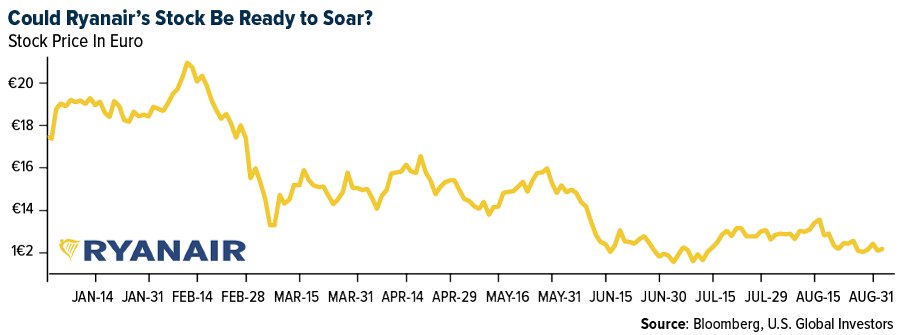
- The worst looks to have passed for tankers, with the upcycle arriving. The crude tanker orderbook is below 5% and shipyards have been largely booked out in the coming years given a rush of orders from containers and LNG. On the demand side, seaborne crude volumes should continue to recover, remaining 5-10% below pre-Covid levels and inventories need to be restocked, with additional demand from longer distance shipments relating to Russia/Ukraine conflict and rising U.S. exports.
- Shares of United Airlines performed well this week, owed to the bullish revenue guidance provided by the carrier for third quarter 2022, reports Nasdaq – particularly on the back of a robust demand environment.
Threats
- U.S. intent to travel showed a sharp/sudden drop in the month of July, according to Morning Consult data. “While concerns of rising Covid cases may play a part in this decline, a more significant factor is the economy. In fact, 43% of Americans say they’re traveling less this summer because of higher prices.
- Last week, for the first time in more than a year, new VLCC crude tankers were ordered. Right now, there are only 40 VLCC’s on order which is the lowest number since April 1997. To put that in context, Global oil production was 71 million barrels per day in 1997 as compared to nearly 100 million barrels per day this year.
- In Mexico, according to Credit Suisse, after a solid month for consolidated traffic during July, the bank expects weaker levels in August as it marks the end of the year-high demand brought by the summer season. It is worth noting that in leisure and VFR destinations, airlines tend to reduce capacity and load factors tend to weaken from July to August. Business destinations show less elasticity and capacity tends to remain roughly flat.
Emerging Markets
Strengths
- The best performing country in emerging Europe for the week was Turkey, gaining 9.3%. The best performing country in Asia this week was China, gaining 2.4%.
- The Hungarian forint was the best relative performing currency in emerging Europe this week, gaining 2.3%. The Thailand baht was the best performing currency in Asia this week, gaining 0.8%.
- While economists around the world are reporting higher inflation, China which is the world’s second largest economy, this week reported weaker CPI data. Year-over-year prices increased 2.5% in August, below consensus of 2.8% and July’s reading of 2.7%. Core inflation was steady at 0.80%. According to Bloomberg, the world economy weighted inflation is at 9.8%.
Weaknesses
- The worst performing country in emerging Europe for the week was Hungary, losing 2.5%. The worst performing country in Asia this week was the Philippines, losing 1.2%.
- The Romanian leu was the worst performing currency in emerging Europe this week, losing 0.7%.
- The Pakistani rupee was the worst performing currency in Asia this week, losing 3.9%.
- Exports and imports slowed sharply in China. In dollar terms, they grew only 7.1% year-over-year in August, down from 18% growth in July. Bloomberg economists were expecting export growth of 13.5%. Imports grew just 0.30% year-over-year versus the expectation of 1.6% growth and 2.3% growth in July.
Opportunities
- Chinese stocks bounced this week after President Xi signaled more support for the economy. He called, once again, to accelerate technical development in order to strengthen national security. Specific areas of focus will include artificial intelligence, semiconductors, and biotechnology.
- Wood & Company published a positive report on Greece this week. The broker believes that the country will benefit from a cumulative 51 billion euros (23.3% of the 2022 estimated GDP) worth of funds, divided between the recovery fund (30.5 billion euros) and the cohesion policy funds (21 billion euros) in the coming five years. Tourism revenue has also risen this year and most likely tourism will remain the country’s strength.
- Europe is experiencing record high energy prices due to a supply squeeze after the war in Europe erupted at the end of February. Russia stopped exports of gas to Europe through the NS1 and the Eurozone agreed to cut oil imports from Russia by 90% by the end of this year. Poland is one of few countries that have been diversifying its energy sources even before the war, and this week it announced that Poland reached a new record of solar energy production, representing 33% of energy production at the moment, according to PSE grid operator data.
Threats
- Central emerging Europe countries continue to hike rates. Hungary’s one-week repo rate was unchanged at 11.75%, at a level last seen in 2004. This week Poland hiked by another 25 basis points to 6.75%, a level last seen in 2003. There was not a rate decision in the Czech Republic this week, but rates are elevated there too. The European Central Bank (ECB) hiked by 75 basis points, and the Bank of England delayed its rate decision until September 22, due to the death of 96-year-old Queen Elizabeth.
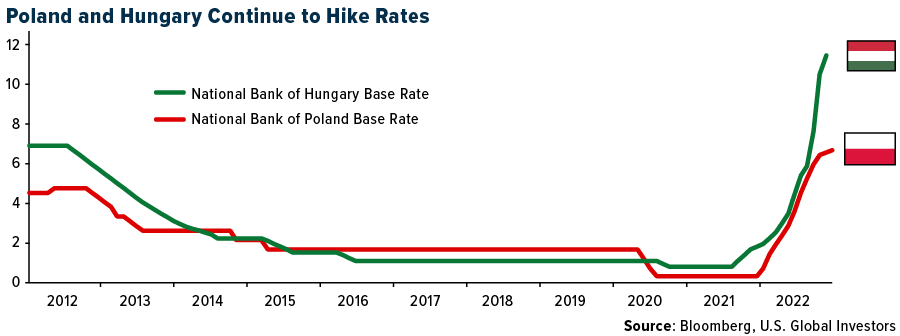
- Russia did not renew the flow of gas to Europe through Nord Stream 1 after its three-day maintenance. Many doubted that the gas would be exported though the pipeline again, but it was already operating at a very low level of only 20% capacity. On a positive note, gas inventories in central emerging Europe are at a normal level. In Poland, gas inventories are now at 98% full. In the Czech Republic, numbers are in line with the EU average. In Romania, inventories are around last year’s level, but Hungary is lagging significantly making it the country most in danger, Wood & Company reported.
- The yuan reached a fresh multi-year low against the dollar. The Chinese government is concerned with the pace and the magnitude of the yuan’s depreciation. The yuan has approached 7.00 yuan to one dollar this week, a level last seen in 2020, declining 8.2% against the dollar year-to-date.

Energy & Natural Resources
Strengths
- •The best performing commodity for the week was wheat futures, up 7.52%, as optimism regarding wheat supplies from Ukraine wane with delays to shipping. Iron ore was also stronger this week on optimism surrounding the upcoming construction season in China, which runs through October, which should lift steel demand.
- The Singapore Exchange is introducing new forward contracts on cobalt and lithium this month as battery materials demand accelerates in the global transition to an electric future.
- Members of Union No. 1 voted 96% in favor of partial strikes next week at BHP’s Escondida copper mine in Chile, reports Bloomberg. The union said the protest alleged unsafe working conditions at the mine site. BHP noted that it had temporarily closed the area regarding a dump location and a sinkhole. The partial strikes will take place over a one-week period, to be extended indefinitely if BHP does not resolve the issues.
Weaknesses
- The worst performing commodity for the week was natural gas, down 8.31%. International prices are taking a hit after the European Union proposed price caps on natural gas. The plan envisions taking windfall profits from energy companies and redirecting the proceeds to struggling consumers.
- Iron ore plunged to a 10-month low early in the week on demand being stifled by more lockdowns in megacity Chengdu, China. Peak construction season in China is September through October and exceptional price weakness does not bode well for iron ore markets, was the sentiment.
- Aluminum stockpiles on the LME jumped 11% last Tuesday, the most since February, plus rebounding from a three-decade low marked in August. Inventories are critically low but growing concerns over a deteriorating outlook have investors worried.
Opportunities
- Chileans soundly rejected the new constitution on Sunday, instead of opting to stick with the current investor-friendly magna carta. The proposed constitution would have created one of the heaviest tax burdens for copper producers, compared to other copper producing nations, and included tougher environmental rules. Chile provides more than 25% of the world’s copper production. Major copper producers can develop new copper mines in other countries, but the vote increases the likelihood we will see new investment in Chile.
- Tesla is considering building a lithium hydroxide refinery that potentially could be built in Texas or Louisiana, likely contingent on local tax breaks. Such a refinery would be the first of its kind built in North America. Dozens of similar projects are underway in other nations such as Australia and Germany, but China currently dominates lithium refining with more than 50% of global capacity. In related news, General Motors plans to introduce a mass market SUV electric vehicle (EV) priced at $30,000 with a 250-mile range. This is part of GM’s $35 billion capital spend to overtake Tesla in EV sales.
- Copper spreads are spiking in a signal that physical supplies remain tight globally despite of the threat of a recession. According to Bloomberg, the premium for cash copper over three-month futures on the LME jumped 91% on the past Thursday to $145 per metric ton. Such a premium illustrates that buyers need the metal now.
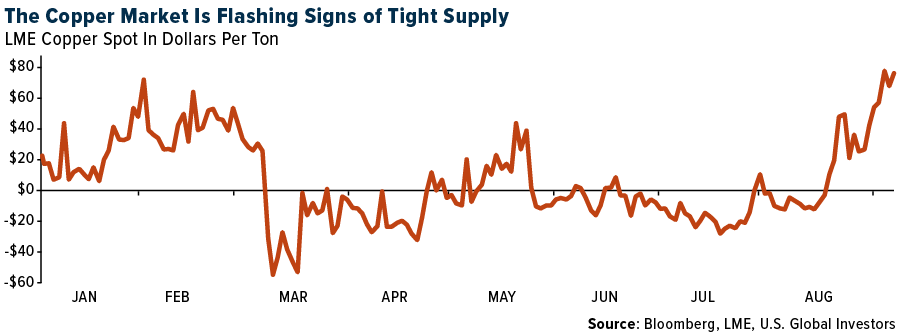
Threats
- Polysilicon prices have risen to a 10-year high on the back of strong solar panel demand which has prompted the China Silicon Industry Association to suspend publishing the price of this key raw material, according to Bloomberg. China previously halted the posting of thermal coal prices when prices surged, likely to avoid additional speculation on a commodity that is in short supply.
- CEO Andrew Cole of Oz Minerals warned investors that historically low copper and nickel discoveries are setting up a long-term shortage of these metals which will be critical to our decarbonization path. In sharp contrast, Huw McKay, Chief Economist of BHP Group, predicted a looming surplus of copper and nickel that would push prices down. Cole didn’t discount short-term volatility and emphasized that the medium- to long-term outlook could be a case of chronic undersupply.
- The Inflation Reduction Act (IRA) is likely to accelerate a shift away from cobalt, as the act supports U.S.-made electric vehicles, BofA commodity strategist Michael Widmer writes in a note. Under the status quo, cobalt is unlikely to make a meaningful contribution toward qualifying for the tax credit, because it is mostly mined in the Democratic Republic of Congo (DRC) and processed in China. As such, there is now a stronger case to increase market penetration rates of lithium iron phosphate (LFP) batteries, which do not contain nickel or cobalt, Widmer says “This may well mean that cobalt demand growth could remain subdued going forward,” the strategist adds.
Luxury Goods
Strengths
- Volkswagen is pushing ahead with its plan to list a minority stake in the Porsche sports-car maker in Europe despite worsening macro conditions in the region. The manufacturer is planning the initial public offering as early as this month unless markets worsen significantly.
- Initial jobless claims in the United States declined to 222,000 from 232,000, and below the estimated 235,000. However, continuing claims slightly rose from 1,438,000 to 1,473,000.
- The RealReal, an online retailer, was the best performing equity in the S&P Global Luxury Index this week, gaining 16.43%. Shares gained more than 10% on Friday, supported by strong performance among luxury names. However, year-to-date, the stock is still the worst performer among members of the S&P Luxury Index, declining 79.33%.
Weaknesses
- Final U.S. Service PMI declined to 43.7 in August from the preliminary reading of 44.1. Most Bloomberg economists were expecting a slightly higher data point of 44.2.
- China will impose national Covid restrictions from September 10 to October 31, to avoid large scale outbreaks during the time of increased travel. Travelers will be required to have negative 48-hour PCR tests in order to use public transportation and a 72-hour negative test will be required to enter hotels, tourist sites and other crowded areas. Golden Week this year will be celebrated in China in the first week of October.
- Porsche Automobile Holding SE, was the worst performing stock in the S&P Global Luxury Index this week, losing 8.2%. Porsche and Red Bull have ended talks over Porsche joining Formula One, but the German sports car brand remains interested in entering the racing series, it said on Friday. Also, Volkswagen announced on Monday it would list sports car brand Porsche AG this month or in early October. Some investors are skeptical about the timing of the IPO and question whether Mr. Blume, CEO of Volkswagen, will be capable of managing both companies.
Opportunities
- Bank of America’s luxury research team is bullish on the luxury sector. They believe companies will be able to navigate the macro backdrop better than what is currently priced in. High income consumers will continue to buy expensive services and products, regardless on deteriorating economic conditions. The broker recommends a buy on Louis Vuitton (LVMH), Richemont and Hermes among large-cap names, and has a buy recommendation on Swatch, Prada, and Moncler among mid-cap names.
- Oddo BHF is optimistic about luxury goods’ performance as well. The broker says that the 12-month outlook for luxury goods stocks remains favorable, with possible 15-20% upside in a base scenario. The brokerage says Hermes is its top pick, while Louis Vuitton (LVMH) and Moncler are also in strong positions to cope with a slowdown.
- More Americans are deciding to buy luxury cars than ever before. The share of new vehicles sold by luxury brands, like BMW, Mercedes-Benz, and Tesla, has steadily grown in recent years, hitting a record 17.3% of the overall U.S. car market in June, according to J.D. Power, a data analytics firm focused on the auto industry. That percentage is up from 14.1% in 2019 and continues a rise that began years earlier, industry data shows and Bloomberg reports.
Threats
- While luxury demand in China has clearly rebounded in July-August, the Zero- Covid policy creates a lack of visibility on demand in the second half of the year, Bank of America research team wrote in its report titled “Key Themes from BofA China Fieldtrip,” dated September 5. Important luxury cities have imposed Covid restrictions, surpassing people’s free movement and affecting customer spending habits. Guangzhou and Shijiazhuang are just two cities that imposed new restrictions and they account for 2-8% of global revenue.
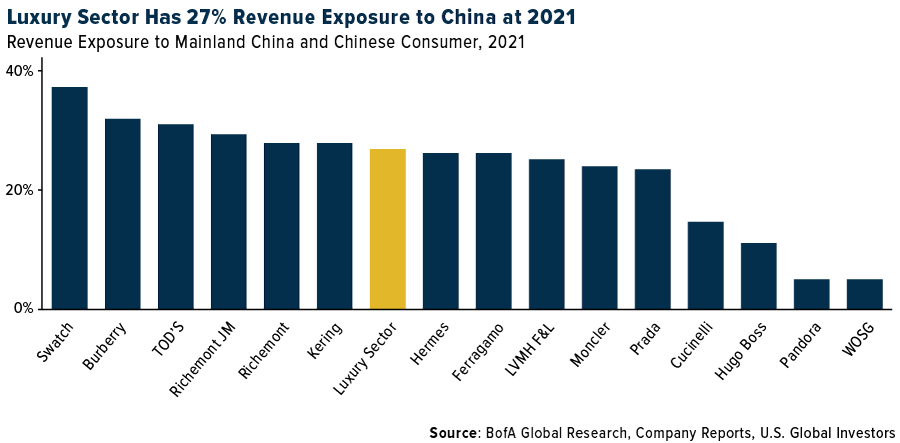
- Bloomberg economists predict initial jobless claims and continuing claims in the United States to increase next week. The data will be released September 15.
- Inflation data for the United States will be released next week as well. Bloomberg economists are predicting the CPI to decline to 8.1% in August from 8.5% in July, but to remain at an elevated level last seen two decades ago. The Federal Reserve may have to hike rates again soon to bring it lower.
Blockchain and Digital Currencies
Strengths
- Of the cryptocurrencies tracked by CoinMarketCap, the best performer for the week was Terra LUNA, rising 216.98%.
- Ether is outperforming the broader crypto market as the latest software update to the Ethereum network kicks off one of the last legs of the long-anticipated transition of the blockchain to a more energy-efficient process, reports Bloomberg. The latest upgrade to the Ethereum network, known as Bellatrix, was activated at around 7:35 a.m. New York time. It officially kicks off the blockchain’s transition from proof of work to proof of stake, the article continues.
- Thailand will establish a working group to study improving supervision of digital assets to enhance investor protection and follow international standards, according to the Securities and Exchange Commission. The group will consist of representatives from agencies including the finance ministry and Bank of Thailand. Improving supervision will help prepare for fast changes in the digital asset market, Bloomberg reports.
Weaknesses
- Of the cryptocurrencies tracked by CoinMarketCap, the worst performing for the week was NEXO, down 14.61%.
- Bitcoin is flirting with a test of this year’s lows following a cryptocurrency selloff that again pushed the sector’s overall market value below $1 trillion. Bitcoin has shed more than 6% so far this week and was trading at about $18,750, Bloomberg explains. Surging real interest rates are heaping pressure on a range of risk assets and crypto is no exception.
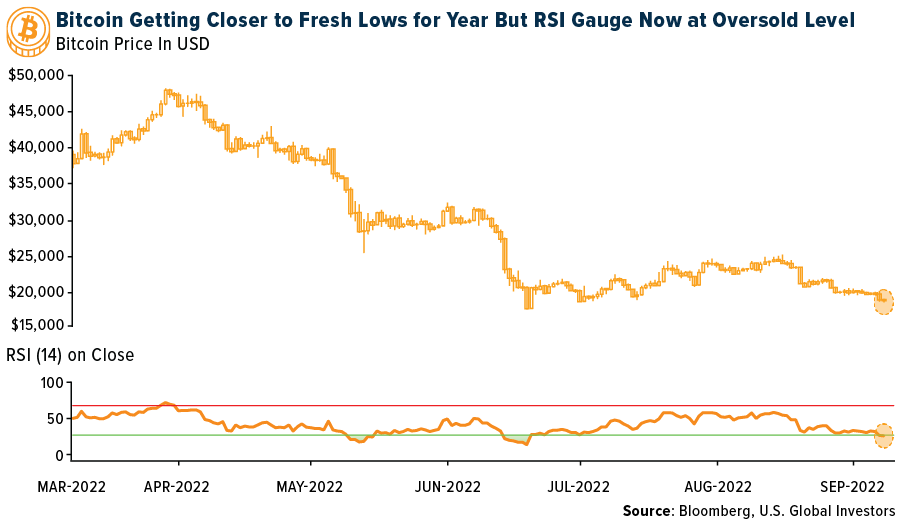
- Scammers who ransacked cryptocurrency projects to the tune of hundreds of millions of dollars in recent months have been able to carry out such heists by taking advantage of a central tenet of decentralized financial services. While DeFi projects promise to enable more efficiency in crypto transactions, much of the code undergirding the software is public, meaning anyone online can scan it for possible vulnerabilities they can exploit, writes Bloomberg.
Opportunities
- Binance the largest crypto exchange by volume, will start converting any existing user balances and new deposits of USDC, USDP, and TUSD into the company’s own stablecoin. The exchange said the move is intended “to enhance liquidity and capital-efficiency for users,” writes Bloomberg.
- Insolvent crypto lender Voyager Digital has drawn enough interest from potential buyers to necessitate an auction, reports Bloomberg. The need for an auction means Voyager received more than one acceptable bid for its assets and no bid was clearly the best. That could be good news for Voyager customers still locked out of their accounts, the article continues.
- GameStop shares were up on Thursday after the video game retailer announced a partnership with cryptocurrency exchange FTX US, suggesting the company is making strides in its strategy shift to NFTs. But analysts were still skeptical about the long-term growth prospects after the company reported a decline in sales and a wider loss in the second quarter. GameStop said it will collaborate with FTX US on new e-commerce and online marketing initiatives and will begin carrying FTX gift cards in select stores, writes Bloomberg.
Threats
- The securities and exchange commission of Thailand has filed a police complaint against Zipmex Thailand, a crypto exchange operator, and its chief executive officer for not complying with the country’s digital assets regulations, writes Bloomberg. The CEO of the exchange Akalarp Yimwilai violated the digital assets rules by not disclosing information about the bourse’s digital wallet, which holds customers’ assets, and details about transfers and withdrawals of digital assets as requested by authorities.
- A closely watched measure of Bitcoin mining revenue has dropped to the lowest in about two years as competition increases while prices drop and energy costs soar. The hash price index, which indicates the mining revenue value per unit of computing power, dropped to around 7.7 cents for each terahash, the lowest since September 2020.
- The White House Office of Science and Technology released a report claiming Bitcoin mining negatively impacts the environment and hints toward banning proof-of-work, according to Daily Bitcoin News. The report alludes to possible executive orders and legislation from congress to “limit” or “eliminate” proof-of-work mining if regulatory actions fail to influence U.S. climate goals, the report says.

Gold Market
This week gold futures closed at $1,726.90, up $4.30 per ounce, or 0.25%. Gold stocks, as measured by the NYSE Arca Gold Miners Index, ended the week higher by 5.51%. The S&P/TSX Venture Index came in up 2.14%. The U.S. Trade-Weighted Dollar fell 0.49%.
| Date | Event | Survey | Actual– | Prior |
|---|---|---|---|---|
| Sep-8 | ECB Main Refinancing Rate | 1.250% | 1.25% | 0.500% |
| Sep-8 | Initial Jobless Claims | 235K | 222K | 232k |
| Sep-13 | Germany CPI YoY | 7.9% | — | 7.9% |
| Sep-13 | Germany ZEW Survey Expectations | -60.0 | — | -55.3 |
| Sep-13 | Germany ZEW Survey Current Situation | -52.1 | — | -47.6 |
| Sep-13 | CPI YoY | 8.1% | — | 8.5% |
| Sep-14 | PPI Final Demand YoY | 8.8% | — | 9.8% |
| Sep-15 | Initial Jobless Claims | 227k | — | 222k |
| Sep-15 | Retail Sales YoY | 3.2% | — | 2.7% |
| Sep-16 | Eurozone CPI Core YoY | 4.3% | — | 4.3% |
Strengths
- The best performing precious metal for the week was palladium, up 7.10%. Gold advanced this week to its highest level since late August, actually firming its price trajectory in the face of another super-sized rate hike in September. However, dollar weakness surfaced this week as the Bank of Japan governor held a meeting with the Prime Minister over a fall in the yen, which has dropped even further against the dollar than the euro. Gold coin and bar sales by the Perth Mint rose 7.2% in August to 84,976 ounces.
- Aya Gold & Silver reported initial drill results from its brownfield Boumadine property in the Kingdom of Morocco. Preliminary results indicate the mineralization from holes drilled between the Central Zone and the South Zone now link the precious metals over a 2.7-kilometer strike. President and CEO Benoit La Salle noted the excitement with these new high-grade holes that expands the potential for the company’s next leg of growth.
- Reunion Gold reported significant gold intersections from its Oko West Project in Guyana. Hole D22-135 intersected 5.19 grams per ton (g/t) over 52.50 meters. Hole D22-124 intersected 4.12 g/t over 49.80 meters, and Hole D22-127 clipped 3.18 g/t over 48.50 meters. Given the success so far in drilling, Reunion plans to aggressively grow the size of the deposit with the addition of two higher capacity diamond rigs, bringing the total number of drills up to five on the property. Reunion Gold continues to advance its way through the permitting process and expand its ground position.
Weaknesses
- The worst performing precious metal for the week was gold, but still up 0.49%. Technical analyst Nour Al Ali at Bloomberg noted this week that the statistical relationship between gold and the dollar is shifting again, with the inverse correlation to the U.S. Dollar Index approaching -0.6, while a month back the relationship was more in the -0.2 to -0.3 range. Regardless, bullion is finding support even as the greenback hovers near a record.
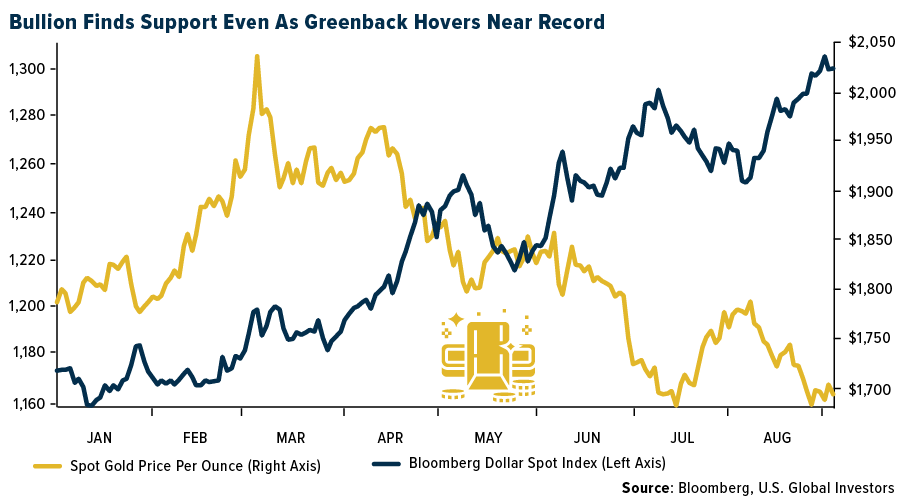
- For the third time in three years, protests at the Los Filos mine in Mexico have shut down operations for Equinox Gold’s biggest mine. The company’s share price sunk as much as 8% intraday on the news, but still closed the week with a net price gain.
- Anglo American Platinum announced a cut in output forecast for the year as the rebuild of the Polokwane smelter, north of Johannesburg, will be delayed another two months, knocking 5% off of its price. The reduction of anticipated production could boost overall PGM prices.
Opportunities
- Platinum supply concerns could re-emerge as buyers seek to avoid Russian sourced metal, according to the World Platinum Investment Council (WPIC). Companies with current contracts in force to purchase may not renew the contracts with Russian counterparties, according to WPIC. Russia supplies about 11% of the world output, making it the second biggest producer outside of South Africa. WPIC forecasts PGM demand to rise 14% in 2022, perhaps pushing prices higher.
- B2Gold gained over 16% for the week on speculation of a potential takeover with its current share price weakness. Earlier terrorist attacks in Mali over the summer has weighed on many of the West African producers. B2Gold’s flagship Fekola Mine in Mali would be an enviable target.
- EMX Royalty Corporation has received is initial royalty payment on gold production from the Gediktepe Mine in western Turkey and operated by a private Turkish company. EMX has a 10% net smelter return (NSR) on the oxide gold production. The $1.84 million is inclusive of $281,052 in Value Added Tax (VAT) for which EMX has credits to recover. The payments were based on sales from production for June and July. EMX also has a 2% NSR royalty on production from an underlying polymetallic copper, zinc, lead and gold deposit that is scheduled for future development. The junior royalty space could be an area for consolidation.
Threats
- Well known senior editor for markets at Bloomberg, John Authors, wrote an opinion piece titled “Nothing Will Stop the Dollar from Getting Stronger”, due to the extraordinary strength our currency is showing. John notes that only once before this century has the dollar traded so high above its 200-day moving average. This last occurred in 2015 as foreign exchange markets adjusted to the epic fall in oil prices that had started the previous year. The oil price crash in 2014 came as OPEC discipline broke down but was equally matched by a strengthening dollar. Over the last 12 months, the typically inverse relationship of oil price and the U.S. dollar has broken down. Now, both the dollar and the price of oil are rising, which is stressing currency markets around the world.
- The government of Finland is proposing tighter regulations of the mining industry, including improved environmental controls and additional fees, reports Bloomberg. It’s been a decade since Finland has updated its regulations and has been criticized for being too lax on environmental damage from mining and not allowing enough locals to have a voice in how a mine site is developed. Economy Minister Mika Lintila noted that the country needs critical minerals to be mined to support the transition to a more sustainable future.
- Recent research published by the Federal Reserve Bank of Cleveland argues that central banks facing a surprise drop in available workers should take a cautious, rather than an aggressive, approach to monetary tightening even though this will still subject us to a period of higher inflation. They argue that while tighter policy will cool demand for products and labor, an even smaller workforce would push up wage growth and inflation more than it would have been under “optimal” policy. Meanwhile, Fed officials are rapidly raising interest rates to cool the hottest inflation in nearly four decades.

U.S. Global Investors, Inc. is an investment adviser registered with the Securities and Exchange Commission (“SEC”). This does not mean that we are sponsored, recommended, or approved by the SEC, or that our abilities or qualifications in any respect have been passed upon by the SEC or any officer of the SEC.
This commentary should not be considered a solicitation or offering of any investment product. Certain materials in this commentary may contain dated information. The information provided was current at the time of publication. Some links above may be directed to third-party websites. U.S. Global Investors does not endorse all information supplied by these websites and is not responsible for their content. All opinions expressed and data provided are subject to change without notice. Some of these opinions may not be appropriate to every investor.
Holdings may change daily. Holdings are reported as of the most recent quarter-end. The following securities mentioned in the article were held by one or more accounts managed by U.S. Global Investors as of (06/30/22):
United Airlines
Ryanair Holdings Plc
Tesla
Volkswagen
Louis Vuitton
Richemont
Hermes
Moncler
Aya Gold & Silver
Reunion Gold
Anglo American Platinum
EMX Royalty Corporation
*The above-mentioned indices are not total returns. These returns reflect simple appreciation only and do not reflect dividend reinvestment.
The Dow Jones Industrial Average is a price-weighted average of 30 blue chip stocks that are generally leaders in their industry. The S&P 500 Stock Index is a widely recognized capitalization-weighted index of 500 common stock prices in U.S. companies. The Nasdaq Composite Index is a capitalization-weighted index of all Nasdaq National Market and SmallCap stocks. The Russell 2000 Index® is a U.S. equity index measuring the performance of the 2,000 smallest companies in the Russell 3000®, a widely recognized small-cap index.
The Hang Seng Composite Index is a market capitalization-weighted index that comprises the top 200 companies listed on Stock Exchange of Hong Kong, based on average market cap for the 12 months. The Taiwan Stock Exchange Index is a capitalization-weighted index of all listed common shares traded on the Taiwan Stock Exchange. The Korea Stock Price Index is a capitalization-weighted index of all common shares and preferred shares on the Korean Stock Exchanges.
The Philadelphia Stock Exchange Gold and Silver Index (XAU) is a capitalization-weighted index that includes the leading companies involved in the mining of gold and silver. The U.S. Trade Weighted Dollar Index provides a general indication of the international value of the U.S. dollar. The S&P/TSX Canadian Gold Capped Sector Index is a modified capitalization-weighted index, whose equity weights are capped 25 percent and index constituents are derived from a subset stock pool of S&P/TSX Composite Index stocks. The NYSE Arca Gold Miners Index is a modified market capitalization weighted index comprised of publicly traded companies involved primarily in the mining for gold and silver. The S&P/TSX Venture Composite Index is a broad market indicator for the Canadian venture capital market. The index is market capitalization weighted and, at its inception, included 531 companies. A quarterly revision process is used to remove companies that comprise less than 0.05% of the weight of the index, and add companies whose weight, when included, will be greater than 0.05% of the index.
The S&P 500 Energy Index is a capitalization-weighted index that tracks the companies in the energy sector as a subset of the S&P 500. The S&P 500 Materials Index is a capitalization-weighted index that tracks the companies in the material sector as a subset of the S&P 500. The S&P 500 Financials Index is a capitalization-weighted index. The index was developed with a base level of 10 for the 1941-43 base period. The S&P 500 Industrials Index is a Materials Index is a capitalization-weighted index that tracks the companies in the industrial sector as a subset of the S&P 500. The S&P 500 Consumer Discretionary Index is a capitalization-weighted index that tracks the companies in the consumer discretionary sector as a subset of the S&P 500. The S&P 500 Information Technology Index is a capitalization-weighted index that tracks the companies in the information technology sector as a subset of the S&P 500. The S&P 500 Consumer Staples Index is a Materials Index is a capitalization-weighted index that tracks the companies in the consumer staples sector as a subset of the S&P 500. The S&P 500 Utilities Index is a capitalization-weighted index that tracks the companies in the utilities sector as a subset of the S&P 500. The S&P 500 Healthcare Index is a capitalization-weighted index that tracks the companies in the healthcare sector as a subset of the S&P 500. The S&P 500 Telecom Index is a Materials Index is a capitalization-weighted index that tracks the companies in the telecom sector as a subset of the S&P 500.
The Consumer Price Index (CPI) is one of the most widely recognized price measures for tracking the price of a market basket of goods and services purchased by individuals. The weights of components are based on consumer spending patterns. The Purchasing Manager’s Index is an indicator of the economic health of the manufacturing sector. The PMI index is based on five major indicators: new orders, inventory levels, production, supplier deliveries and the employment environment. Gross domestic product (GDP) is the monetary value of all the finished goods and services produced within a country’s borders in a specific time period, though GDP is usually calculated on an annual basis. It includes all private and public consumption, government outlays, investments and exports less imports that occur within a defined territory.
The S&P Global Luxury Index is comprised of 80 of the largest publicly traded companies engaged in the production or distribution of luxury goods or the provision of luxury services that meet specific investibility requirements.
The Bloomberg Dollar Spot Index tracks the performance of a basket of 10 leading global currencies versus the U.S. Dollar.
The Shanghai Containerized Freight Index reflects the ocean freight and the associated seaborne surcharges of individual shipping routes on the spot market.





























